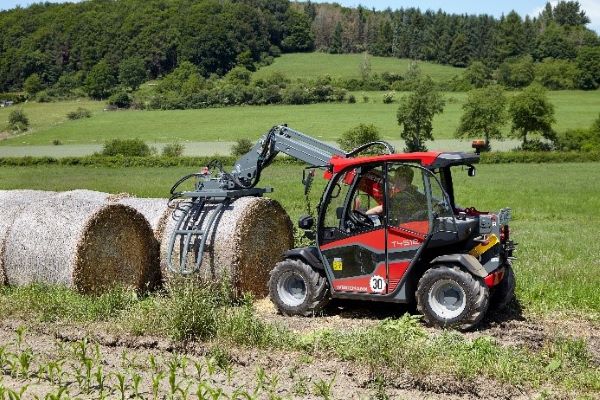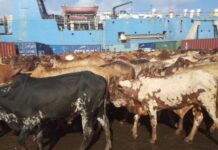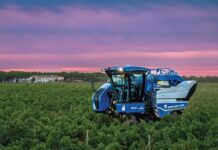In 2010, Weidemann was one of the first manufacturers to launch a small compact telehandler with a side-mounted engine on the market. “In those days, our competitors were asking us what we were looking to shift with this little toy”, grinned the Commercial Director, Bernd Apfelbeck, as he recalled those days. “In subsequent years, the machine filled a genuine market niche, and in the last 10 years it has become one of our big bestsellers in our diverse product range. Its unique combination of lifting heights, compact dimensions and machine performance are what make it impressive. A lifting height of 4.5 m means that it can be used in a wide range of stacking and loading tasks. It also makes light work of lifting over most high boards. Its significant 1.25 tonne payload means that large bales of any kind and various weights of material pose no problem. Oh yes, and the compact dimensions – a width of just 1.56 m and a height of less than 2m – are a real highlight of this machine. These dimensions enable the machine to move through areas where clearance is limited and to work in tight spaces. The telehandler can also be transported on a trailer, so that it can be used at various locations to undertake loading work. When taken together, all these features are ultimately what have made our T4512 so successful in so many different sectors.
“But now we are looking to the future,” said Bernd Apfelbeck as he continued to talk about his success model, “converting the engine to level V is our number one priority and we have taken the opportunity to rethink the T4512 once again with the aim of optimising it even further. Is it possible to improve a bestseller? That’s what we have asked ourselves at Weidemann, and we are delighted that we can now present you with the results of our research.”
New electronically regulated traction drive for optimal power delivery.
The T4512 continues to be available from Yanmar with two different engine versions. However, the basic engine now has an output of 18.4 kW /25 hp and the larger engine has an output of 33.3 kW/45 hp (engine powers were previously 31 or 40 hp). The new basic engine therefore has a nominally lower output than its predecessor. However, according to the manufacturer’s information, its performance is improved. You might be wondering how that is possible. The solution lies in Weidemann’s exclusive and brand-new development of an electronically regulated traction drive, known as the ecDrive (Electric Control Drive), which enables the machine’s overall performance to be increased, even in lower hp categories. Another advantage is that the 18.4 kW engine entirely fulfils the exhaust emission stage V, without any need after-treatment of exhaust gases. This engine version is particularly well-suited to users who require less operating hours from their machine.
The 45 hp option has been converted to exhaust emission standard level V with the installation of a diesel particle filter (DPF) together with a diesel oxidation catalyst (DOC). With this technology, there is no need to add any urea solution (DEF). The entire engine unit comes from Yanmar, complete with exhaust after-treatment, so that all components are perfectly synchronised with each other and the machine completes an automatic regeneration at the relevant operating temperature. The smaller engine has a top speed of 20 km/h. With the larger engine, there is now a choice of top speeds: either 20 or 30 km/h. The work hydraulics of the new telehandler operate at 28.6 l/min, or alternatively at 42 l/min or even at 70 l/min with the High Flow option. The tank volume has been increased to 33 litres, thus extending the machine’s operating time. Another new feature of the T4512 is an optional reversing fan, so that even in dusty working conditions, clean air can be filtered into the operator’s cab through an air-conditioning unit and ventilation grille, making the operator’s conditions more comfortable and ensuring the machine achieves its full cooling efficiency. In redesigning the telehandler, Weidemann has generally paid great attention to making considerable improvements to maintenance and service access. As a result, the engine bonnet can be fully opened up and all components requiring maintenance are positioned to ensure they are easy to access. The layout of the technical components in the engine compartment has been redesigned: the hose and cable routing has fixed points and brackets, and safety mechanisms, relays and controllers are also optimally positioned. This all makes repair work easy when it comes to servicing the machine.
Weidemann ecDrive – the new electronically regulated traction drive.
The new electronically regulated traction drive, ec Drive (Electronic Controlled Drive), enables the telehandler to be used and driven exactly as required. Weidemann has fitted four different drive modes specifically for this purpose. The auto mode ensures the usual 100% performance of the machine. In eco-mode, the engine speed reduces to 2200 revs/min once the desired driving speed has been reached. This enables a reduction of noise as well as a saving on fuel.
The two other optional drive modes are designed specifically for use with hydraulically-operated attachments or for the optimised execution of the Y loading cycle. The mode known as attachment mode supports the use of attachments. Here, the operator sets the speed of the diesel engine with the throttle and controls the driving speed with the foot pedal or cruise control. With these controls, speeds can be very finely set in increments of 0.1 km/h, via the display. This ensures a constant feed for the attachment. If the load on the attachment is too great (e.g. various cut material in front of a mulcher), the machine automatically restricts the speed to ensure the best possible performance for the attachment. Once the load is cleared, the machine returns to the preset speed. This is done using a cruise control function. However, if the operator still wishes to drive or reverse at a higher speed, they can override the cruise control at any time via the foot pedal, and can even increase the speed of the machine to its maximum.
The M-drive mode should be used for the optimised execution of Y loading cycles: Here, the operator sets the engine speed with the throttle and controls the driving speed and/or control pressure with the foot pedal. This dispenses with the need for “inching” and supports the execution of fast Y loading cycles.
These new drive modes enable sensitive control of the telehandler T4512 and of the quantity of hydraulic oil dispensed for the various attachments in operation. The loading operation and/or use of attachments is thus significantly more efficient and more convenient.
The new electric handbrake provides another auto-hold function, in addition to the hill-hold function. The brake is applied automatically when the machine comes to a standstill, when the machine is in neutral or when the operator leaves the cab. The handbrake is likewise automatically released when the machine is engaged using the foot pedal. Naturally, the brake can also be applied or released manually by pressing the switch.
Three steering types for flexible use
The all-wheel steering, a legacy of its predecessor, provides full manoeuvrability and power distribution in small spaces. Another new feature of the T4512 are the two optional steering types. One feature that everyone will already be familiar with from Weidemann’s larger telehandler models is front-wheel steering; this ensures safe operation, even at high speeds, for example, on road journeys. And crab steering enables digitally precise navigation when driving sideways, such as when there is a need to move away from a wall when working alongside it.
Ergonomic cab comfort with a multifunctional joystick
The machine has a brand new, redesigned interior and colour-coded operational concept.
The ergonomic comfort of the cab provides a clearly designed, colour-coded switch layout. All operating elements are within easy reach and a well-designed display provides the operator with a constant view of key machine information. Amongst the cab’s new features fitted as standard are a 3-pin plug socket, a fold-down armrest with storage compartment, a drinks holder and storage net. A radio and a USB connection can now also be fitted as additional options. The steering wheel can be individually adjusted to suit the operator. This ensures that every operator can work with ergonomic ease, free from fatigue.
The multifunctional joystick enables the operator to manage a number of functions single-handedly. The continuous operation function of the 3rd control circuit is thus easy to activate via a rocker switch on the keypad and can be conveniently operated with proportional control using the joystick – also in both directions via a variable control on the settings wheel. The thumbwheel enables proportional telescoping. The operating speed can thus be adjusted individually. Both electronic functions can also be operated by pressing or locking a button on the joystick. Both electronic functions work independently, so that they can be individually configured by the operator.
Clear display & wedias diagnostics and analytics system.
The well-positioned display in the operator’s visual field provides an optimum overview of the machine. In addition to standard displays such as temperature, fuel level, or operating hours, active functions are also displayed in the cockpit, such as activated electronic functions, the continuous operation of the 3rd control circuit or the activated differential lock. The Weidemann diagnostics and analytics system – wedias – enables a quick and clear assessment of many functions, such as the driving function, telescopic functions, the 3rd control circuit and the engine data, as well as the electronic functions. Active notifications in the display immediately make the operator aware of potential failures, enabling them to respond with all speed. Thanks to the exact designation of the error number, the dealer can come to the machine prepared and with the right spare parts. The subsequent error analysis significantly simplifies further diagnosis and troubleshooting. This saves time, money and, usually, nerves.
A good view and a comfortable environment results in good work.
The clear visibility, that is already an outstanding feature of the existing T4512, has likewise been given a high priority with the relaunch of this machine. The front view onto the working area as well as the view above have been ensured to the best of Weidemann’s ability in the new cab. The viewing area in the cab’s roof has been enlarged to give a clearer view of the working area. Front, rear and roof windscreen wipers are also fitted as standard. These ensure windscreens remain clear, enabling a good view – a clear advantage when it comes to loading and stacking work. The new retractable blind protects the operator from being dazzled by the sun. The rear view has been improved as a result of the rear windscreen, now heated, also being fitted with a windscreen wiper. For an optimal view to the right, the loader has been fitted with a sloping engine bonnet and several rear-view mirrors. The work lights now fitted as standard to the cab roof, front and rear, come as LEDs with 1000 lumens. Additional LED lights can also be fitted in combination with the work lights, for example on the telescopic arm and cab roof, either with 1000 lumens or with a high-performance 2000 lumens.
The new T4512 has also moved on when it comes to the working environment: significant improvements have been made to the cab’s interior by installing a brand-new and even more efficient heating and ventilation system, complete with a fan, fresh air filter and well-positioned air nozzles. When the heat is on outside, we recommend the high-performance air-conditioning system option. Both the large upper door window and the rear windscreen can also be fitted with a ventilation grille. And as with its predecessor, the upper door window can also be opened through a full 180 degrees and can be secured at the back of the cab. These various options enable the operator to decide on their own climate control settings in the cab, according to their individual and temperature preferences.
The unique Vertical Lift System (vls)
The one and only Weidemann-patented and already well-established operator assistance system improves machine stability and continues to be a feature of the new T4512. The vls (Vertical Lift System) enables a fluid method of working and its semi-automated telescoping movement supports working in a complex operating environment. The near-vertical lifting and lowering movement optimises and ensures the machine’s stability. The fluid working method and ease of machine operation increases its handling capacity. Experienced operators can work even faster and more safely with the vls. Inexperienced operators receive valuable support with lifting and loading work.
New dynamic design
In completely redesigning the T4512, providing it with many new functions and features, Weidemann has also given this machine something of a makeover. The dynamically striking form of this machine makes it truly eye-catching, especially when it comes to the engine bonnet with its redesigned air duct and the new cab. Another distinct visual feature is the new red roof hood, that has already been fitted in other models in the Weidemann range.
All things considered, the new telehandler T4512 has been completely redesigned and offers customers many new features and options for tailoring their own machine to suit their own working requirements. This should pave the way for one of the best-selling machines in the Weidemann range to continue its route to success.








